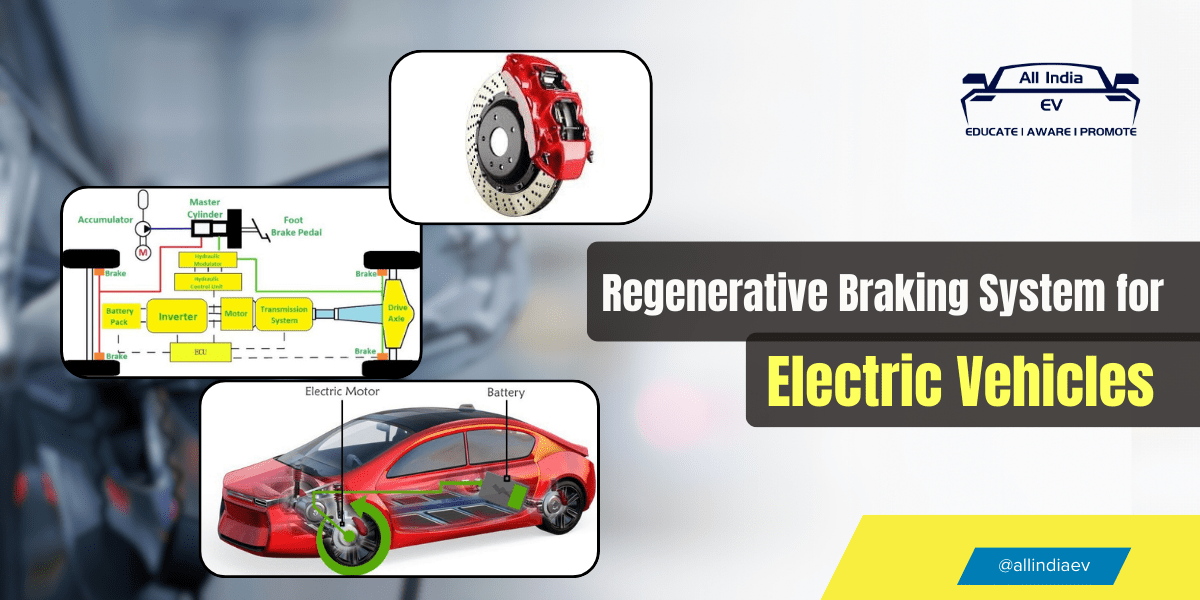
What is Regenerative Braking system and why it is important for electric vehicles?
Regenerative braking is a groundbreaking technology revolutionizing the way electric vehicles operate. By harnessing the kinetic energy generated during braking, this innovative system converts it into electricity, which is then stored back into the vehicle’s battery. This not only enhances energy efficiency but also contributes significantly to sustainable transportation.
How does regenerative braking work in electric vehicles? Can you explain the process in simple terms?
Regenerative braking is a system in electric vehicles that converts kinetic energy (energy of motion) into electrical energy. This is done by reversing the process that powers the electric motor.
Here’s a simplified explanation:
Braking: When you apply the brakes in an electric vehicle, the car’s kinetic energy is converted into heat energy through friction between the brake pads and the wheels.
Motor Reversal: Instead of friction, regenerative braking reverses the electric motor’s function. It turns the engine into a generator.
Energy Capture: As the wheels slow down, the generator starts producing electricity. This electricity is then stored back into the vehicle’s battery.
Think of it like a generator powering a light bulb. When you turn the generator’s handle, it produces electricity that lights the bulb. In regenerative braking, the car’s motion turns the generator, producing electricity that charges the battery.
What are the key components involved in regenerative braking? How do they interact to achieve energy recovery?
The key components involved in regenerative braking are:
Electric motor: This is the primary component acting as a motor and a generator.
Battery: This stores the recovered electrical energy.
Power electronics: This controls the flow of electricity between the motor and the battery, ensuring efficient energy transfer.
The key components involved in regenerative braking are:
Electric motor: This is the primary component acting as a motor and a generator.
Battery: This stores the recovered electrical energy.
Power electronics: This controls the flow of electricity between the motor and the battery, ensuring efficient energy transfer.
Controller: This manages the overall regenerative braking system, determining the amount of braking force and the rate of energy recovery.
Sensors: These measure the vehicle’s speed, wheel rotation, and other parameters to provide feedback to the controller.
How they interact:
Braking signal: When the driver applies the brakes, the controller receives a signal.
Motor reversal: The controller reverses the polarity of the electric motor, turning it into a generator.
Energy generation: As the wheels slow down, the generator produces electricity.
Energy storage: The power electronics direct the generated electricity to the battery for storage.
Braking force control: The controller adjusts the amount of regenerative braking based on the driver’s input and other factors to ensure safe and comfortable braking.
What is the difference between regenerative braking and traditional friction braking? When is each used?
Traditional friction braking:
Uses friction between brake pads and rotors to slow down the vehicle.
Converts kinetic energy into heat energy, which is dissipated into the environment.
Typically used for heavy braking or emergency stops.
Regenerative braking:
Uses an electric motor to slow down the vehicle and recover energy.
Converts kinetic energy into electrical energy, which is stored in the battery.
Typically used for moderate braking or coasting, especially when the vehicle is descending hills.
When each is used:
Regenerative braking: Used primarily for moderate braking and coasting, as it helps to conserve energy and extend the vehicle’s range.
Traditional friction braking: Used for heavy braking, emergency stops, or when the battery is fully charged and cannot accept more energy.
A combination of regenerative and traditional braking is often used to provide optimal braking performance and energy efficiency.
What are the primary benefits of regenerative braking in electric vehicles? How does it contribute to energy efficiency and range?
The primary benefits of regenerative braking include:
Increased energy efficiency: By recovering energy that would otherwise be lost as heat, regenerative braking significantly improves the overall energy efficiency of electric vehicles.
Extended range: The recovered energy can be used to power the vehicle, extending its range between charges.
Reduced wear on brakes: Regenerative braking reduces the reliance on traditional friction brakes, which can extend their lifespan and reduce maintenance costs.
Improved performance: Regenerative braking can provide a more responsive and engaging driving experience, as it can help to slow the vehicle down quickly and smoothly.
Environmental benefits: By reducing the overall energy consumption of the vehicle, regenerative braking can help to reduce greenhouse gas emissions and improve air quality.
How does regenerative braking compare to traditional braking in terms of energy efficiency? Are there any quantitative measurements or comparisons?
Regenerative braking is significantly more energy efficient than traditional friction braking. While traditional braking converts kinetic energy into heat energy, which is lost, regenerative braking captures and stores this energy, making it available for reuse.
Quantitative measurements and comparisons vary depending on factors such as driving conditions, vehicle design, and driving style. However, studies have shown that regenerative braking can improve the energy efficiency of electric vehicles by up to 20% or more.
Can regenerative braking be used to charge the battery fully or only partially? What factors influence the charging efficiency?
Regenerative braking can be used to charge the battery both partially and fully, depending on the amount of kinetic energy available and the battery’s charging capacity.
Several factors influence the charging efficiency of regenerative braking, including:
Battery state of charge: A partially discharged battery can accept more energy from regenerative braking than a fully charged battery.
Driving conditions: Factors such as road grade, traffic conditions, and driving style can affect the amount of kinetic energy available for recovery.
Vehicle speed: Higher speeds result in more kinetic energy, which can lead to more efficient charging.
Regenerative braking system design: The efficiency of the regenerative braking system itself can vary depending on the specific components and controls used.
What are some of the latest technological advancements in regenerative braking systems for electric vehicles? How are these advancements improving performance and efficiency?
Some of the latest technological advancements in regenerative braking systems include:
Advanced control algorithms: More sophisticated control algorithms are being developed to optimize the amount of energy recovered and to ensure smooth and safe braking.
Intelligent energy management systems: These systems can intelligently manage the flow of energy between the battery, motor, and other components to maximize efficiency and range.
Enhanced power electronics: Advances in power electronics are improving the efficiency and reliability of the energy transfer process.
Integration with other vehicle systems: Regenerative braking is being integrated with other vehicle systems, such as traction control and stability control, to provide a more comprehensive and safe driving experience.
These advancements are improving the performance and efficiency of regenerative braking systems, leading to longer range, better fuel economy, and a more enjoyable driving experience.
How does regenerative braking interact with other electric vehicle technologies, such as battery management systems and motor control units? Are there any synergies or challenges?
Regenerative braking interacts closely with other electric vehicle technologies, such as battery management systems and motor control units.
Synergies:
Optimized battery management: Regenerative braking can help maintain a balanced state of charge in the battery, improving its overall performance and lifespan.
Improved motor control: The motor control unit can work in conjunction with the regenerative braking system to ensure smooth and efficient operation.
Enhanced efficiency: The interaction between these systems can lead to improved overall energy efficiency and range.
Challenges:
Coordination: Coordinating the operation of these systems can be complex, requiring careful design and programming.
Efficiency trade-offs: In some cases, optimizing one system may come at the expense of another, requiring careful balancing.
Overall, the interaction between regenerative braking and other electric vehicle technologies is essential for achieving optimal performance and efficiency.
How does regenerative braking contribute to reducing the environmental impact of electric vehicles? What are the potential benefits in terms of emissions reduction and energy conservation?
Regenerative braking plays a significant role in reducing the environmental impact of electric vehicles. By recovering and reusing energy that would otherwise be lost, it helps to:
Reduce greenhouse gas emissions: Electric vehicles already produce significantly fewer emissions than traditional gasoline-powered vehicles. Regenerative braking further reduces emissions by minimizing energy consumption.
Conserve energy: By capturing and storing energy, regenerative braking helps to conserve energy resources.
Reduce reliance on fossil fuels: The reduced energy consumption can help to reduce reliance on fossil fuels, promoting a more sustainable energy future.
What are the prospects for regenerative braking technology? How might it evolve to further enhance the sustainability and efficiency of electric vehicles?
The prospects for regenerative braking technology are promising. As electric vehicles continue to gain popularity, there is a strong incentive for further development and improvement in this area.
Potential future advancements include:
Increased efficiency: Further improvements in the efficiency of regenerative braking systems can lead to even greater energy savings and extended range.
Integration with other technologies: Regenerative braking may be integrated with other emerging technologies, such as advanced battery chemistries and autonomous driving systems, to enhance overall vehicle performance and sustainability.
Cost reduction: As production volumes increase, the cost of regenerative braking systems may decrease, making them more accessible to a wider range of consumers.
By continuing to develop and improve regenerative braking technology, we can contribute to a more sustainable and efficient transportation future.
As electric vehicles continue to gain popularity, regenerative braking technology is poised to play an even more vital role in shaping a cleaner and greener future. With ongoing advancements and increased adoption, regenerative braking will undoubtedly drive the evolution of electric vehicles, making them more efficient, sustainable, and appealing to a wider audience.









